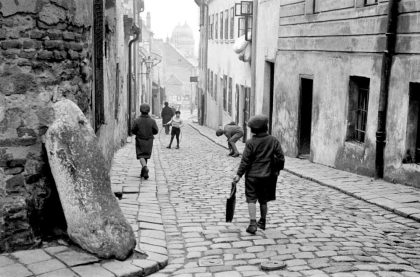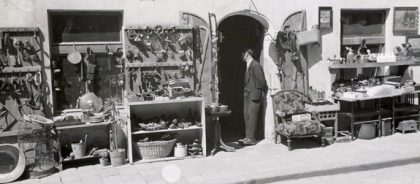
The history of Jews in Slovakia -dating from the sixteenth century under the protection of the Hapsburg- intersects that of their fellow believers in Hungary and the Czech Republic. Jews in these three countries experienced the same vicissitudes of discrimination, expulsions, and, in the seventeenth century, the acquisition of some civil rights. Numerous Jews from neighboring Moravia flocked to Bratislava and nearby cities. At the time a part of norther Hungary, this region was called “Magyar Israel”. Just after the installation of the double Austro-Hungarian monarchy in 1867, the Hungarian Parliament passed a law emancipating the Jews and granting them full civil rights equal to those of other citizens. Their “Magyarization” accelerated, notably in the western cities. The great majority of Slovakian Jews, in contrast, lived in the east in the heart of small, introverted communities following the model of the shtetl of Galicia or Ukraine.
Anti-Semitism in Slovakia is more virulent than in the Czech Republic, where the nationalists reproach the Jews for being German cultural background. In Slovakia, they denounce Jewish assimilation to Hungarian culture. Slovakian Judaism itselt is marked by the struggle between Reform and Orthodox Jews.
With the birth of Czechoslovakia after World War I and the Treaty of Versailles, the Jews also obtained the right to be recognized as a specific nationality. Jewish cultural life bloomed in the new democratic state, where the Jews enjoyed a major economic role, especially in Bohemia-Moravia. They held more than one-third of industrial investments. In contrast, 65% of Slovakian Jews still lived in the countryside in 1930.

The Munich Accords of 1938 and the capitulation of London and Paris in the face of Hitler’s demands led to the dismantling of Czechoslovakia. The Czech territory was separated from the Sudetenland. Slovakia in its turn lost eastern and southern territories to Hungary, regions where some 40000 Jews lived, and became an autonomous region. Less than a year later, in March 1939, Slovakia proclaimed its independence under the protection of Nazi Germany. Slovakia elected Father Josef Tiso as president, and as prime minister Andrej Hlinka, the leader of the Slovakian Peoples’ Party. This religious and extremely right-wing party quickly became the only political party in the country. From the first, discriminatiry measures were taken against the country’s 135000 Jews and were hardened in September 1941 with the promulgation of anti-Jewish legislation in 270 articles. This legislation forced Jews to begin wearing the Star of David and institutionalized forced labor. The deportation of the Jews to death camps (primarily Auschwitz) followed soon after. By the end of 1942, more than three-quarters of Slovakian Jews had been exterminated. The deportations and massacres resumed in April 1944, during the repression of the Slovakian Resistance movement, in which a number of Jews participated. At the end of the war there were no more than 5000 Jews in the country, who had been able to hide themselves with false papers. At most only some 20000 Slovakian Jews survived Nazism.
Bratislava was a large centre for Jewish culture, and flourishing communities existed in small cities such as Kosice or Presov; in the main, however, most Jews traditionally resided in the small western villages of what is today contemporary Slovakia. Some vestiges still exist of the close to 200 synagogues and 630 cemeteries within the boundaries of this new nation, which came to existence 1 January 1993 as part of an amiable separation from the Czech Republic. Most of the remains of a Jewish presence in Slovakia are buried under modern reconstructions or have been left in ruins. Ultimately, these ruins are the last clues to a world that has all but disappeared. Before the war, 135000 Jews (4,5% of the total population) lived within the boundaries of contemporary Slovakia. Today there remain no more than some 4000 Jews, mainly elderly. Of this greatly reduced community, 1000 live in Bratislava.